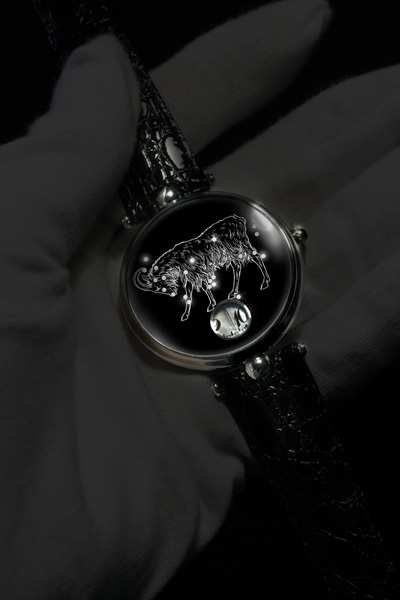Up one level
- Allegories of Art
- Montre Chinoise
- Camaieu Rouge Double Pavé
- MOBIADO
- Tea Clipper
- Allegory of Spring
- Allegory of Wealth
- 2015 Year of the Goat
- Allegory of Spring
- Orbis Signifer - Capricornus
- Incredible India Collection
- Wild Boar
- Bengal Tiger
- King Fisher
- Portrait of a white Horse
- Feeding the Rabbit and Ducks - Wristwatch
- Fire Tiger
- The Kiss
- Blue and White, Famille Rose et Vert Collection
- BouquetBouquet
- Cutty Sark
- Blue Tiger
- Shenlong (Devine Dragon) & Qilin
- Small Dragon on white ground
Orbis Signifer - Capricornus
Description:
Two-body 1.4435Ncu Staybrite Steel case, mirror polished, 7.00 mm hand-winding crown with cabochon Onyx, historic hand-winding movement FHF 96, case caliber 39.00 mm. A Verre Èglomisè miniature on the reverse of the 32.400 ct. sapphire crystal, black lacquered, white lining and diamonds as stars. All 12 Zodiac signs available.
Orbis Signifer denotes an annual cycle of twelve stations along the ecliptic, the apparent path of the sun across the heavens through the constellations that divide the ecliptic into twelve equal zones of celestial longitude. The zodiac is recognized as the first known celestial coordinate system. Babylonian astronomers developed the zodiac of twelve signs. The etymology of the term zodiac is that it comes from the Latin zodiacus, from the Greek, meaning „circle of animals“, derived from , the diminutive of „animal“. However, the classical Greek zodiac also includes signs (also constellations) that are not represented by animals (e.g., Aquarius, Virgo, Gemini and for some Libra). Another suggested etymology is that the Greek term is cognate with the Sanskrit sodi, denoting „a path“, i.e., the path through which the Sun travels. The zodiac also means a region of the celestial sphere that includes a band of eight arc degrees above and below the ecliptic, and therefore encompasses the paths of the Moon and the naked eye planets (Mercury, Venus, Mars, Jupiter, and Saturn). The classical astronomers called these planets wandering stars to differentiate them from the fi xed stars of the celestial sphere (Ptolemy). Astrologers understood the movement of the planets and the Sun through the zodiac as a means of explaining and predicting events on Earth
